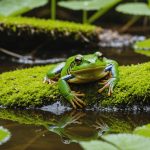Exploring the Effects of UK Water Quality Laws on Amphibian Breeding Grounds: A Comprehensive Study to the Issue
The health of amphibian populations is a critical indicator of the overall environmental well-being of any ecosystem. In the UK, water quality laws play a pivotal role in protecting these delicate habitats. However, the impact of these laws on amphibian breeding grounds is a complex and multifaceted issue that requires a thorough examination.
Amphibians, such as frogs, toads, and newts, are highly sensitive to changes in their environment, making them an excellent biological indicator for the monitoring and assessment of water quality. The UK, with its rich biodiversity, is home to several amphibian species, including the great crested newt, a species of particular conservation concern.
Topic to read : Wildlife-Friendly UK Housing: Innovative Urban Planning for a Sustainable Future
The Impact of Water Quality on Amphibian Habitats
Water quality is a crucial factor in the health and abundance of amphibian populations. Poor water quality can have severe negative effects on amphibian breeding habitats, leading to reduced populations and even local extinctions.
Key Pollutants and Their Effects
-
Heavy Metals: Heavy metals such as lead, mercury, and cadmium can accumulate in water bodies and have toxic effects on amphibians. These metals can disrupt the normal development and physiology of amphibians, leading to reduced fertility and increased mortality rates.
Have you seen this : Innovative Habitat Management by UK Wildlife Trusts: Fostering Biodiversity for Diverse Species
-
Example: A study in England found that ponds with high concentrations of heavy metals had significantly lower amphibian abundance compared to those with cleaner water[1].
-
Chemical Runoff: Agricultural and industrial runoff can introduce a variety of chemicals into water bodies, including pesticides, fertilizers, and industrial pollutants. These chemicals can alter the habitat quality and make it less suitable for amphibian breeding.
-
Example: The use of algaecides in garden ponds has been shown to have a negative impact on the presence and reproduction of amphibians, highlighting the need for careful management practices[1].
-
Disease Dynamics: Poor water quality can also exacerbate disease dynamics among amphibian populations. For instance, the chytrid fungus, which causes a deadly skin disease in amphibians, thrives in polluted environments.
-
Example: Research has indicated that polluted water bodies can increase the susceptibility of amphibians to diseases, further threatening their populations[1].
UK Water Quality Regulations and Their Impact
The UK has implemented various water quality regulations aimed at protecting aquatic habitats, including those of amphibians. These regulations are designed to reduce pollution and maintain healthy water bodies.
Key Regulations
-
The Water Framework Directive (WFD): This EU directive, adopted by the UK, sets out to improve the quality of all water bodies, including rivers, lakes, and wetlands. It requires member states to achieve good ecological status for all water bodies by reducing pollution from agricultural runoff, industrial activities, and other sources.
-
Impact: The WFD has led to significant improvements in water quality across the UK, benefiting amphibian habitats. For example, the reduction in nutrient runoff has decreased the growth of algae, creating a more balanced ecosystem for amphibians.
-
The Environment Act 2020: This act includes provisions to improve water quality, reduce pollution, and enhance biodiversity. It sets out new targets for water quality and introduces measures to reduce the impact of human activities on the environment.
-
Impact: The Environment Act 2020 has strengthened the legal framework for protecting water bodies, including those used by amphibians for breeding. It has also increased public engagement and awareness about the importance of maintaining good water quality.
Conservation Strategies and Habitat Restoration
Effective conservation strategies are crucial for protecting amphibian breeding habitats. Here are some key approaches:
Habitat Restoration
-
Creating Natural Habitats: Restoring natural habitats, such as wetlands and ponds, is essential for providing suitable breeding sites for amphibians.
-
Example: The restoration of a pond in a urban area in England led to the return of several amphibian species, including the great crested newt, highlighting the importance of habitat restoration[1].
-
Managing Pond Features: The management of pond features, such as pond age, area, and vegetation, can significantly impact the abundance of amphibians.
-
Example: A study in Hungary found that older ponds with rubber pond liners and shoreline vegetation were more likely to support amphibian populations[1].
Community Engagement
- Citizen Science Projects: Engaging the public through citizen science projects can provide valuable data on amphibian populations and habitats.
- Example: A country-wide online citizen science survey in Hungary involved over 800 pond owners and provided comprehensive data on the biodiversity of garden ponds, including the presence of amphibians[1].
Practical Advice for Pond Owners
For those who own or manage ponds, there are several practical steps that can be taken to support amphibian breeding habitats:
Best Practices for Pond Management
-
Avoid Using Algaecides: Algaecides can have negative effects on amphibian populations. Instead, use natural methods to control algae growth, such as introducing aquatic plants.
-
Example: Planting aquatic vegetation like water lilies can help maintain a balanced ecosystem and reduce the need for algaecides[1].
-
Maintain Good Water Quality: Regularly test the water quality and take steps to reduce pollution. This includes avoiding the use of chemicals and ensuring that the pond is not contaminated by runoff.
-
Example: Implementing a buffer zone around the pond to absorb runoff can help maintain good water quality[1].
-
Create Diverse Habitats: Ensure that the pond has diverse habitats, including both aquatic and shoreline vegetation. This diversity supports a wider range of species.
-
Example: Incorporating native plants and avoiding the introduction of non-native species can help create a more natural and supportive habitat for amphibians[1].
Long-Term and Short-Term Impacts
The impact of water quality laws and conservation strategies can be seen in both the long term and the short term.
Long-Term Impacts
- Sustained Biodiversity: Good water quality regulations and effective conservation strategies can lead to sustained biodiversity over the long term.
- Example: The long-term protection of wetlands in the UK has resulted in stable populations of several amphibian species, including the great crested newt[1].
Short-Term Impacts
- Immediate Improvements: Immediate improvements in water quality can be seen through reduced pollution and the return of amphibian species to restored habitats.
- Example: The restoration of a polluted pond can lead to the immediate return of amphibian species, as seen in several case studies across the UK[1].
The health of amphibian breeding grounds is intricately linked with water quality. UK water quality laws and conservation strategies play a vital role in protecting these delicate ecosystems. By understanding the impact of pollutants, implementing effective regulations, and engaging in practical conservation efforts, we can ensure the long-term health and abundance of amphibian populations.
Table: Key Factors Affecting Amphibian Breeding Grounds
| Factor | Positive/Negative Impact | Examples |
|---|---|---|
| Heavy Metals | Negative | Lead, mercury, cadmium accumulation in water bodies |
| Chemical Runoff | Negative | Pesticides, fertilizers, industrial pollutants |
| Disease Dynamics | Negative | Chytrid fungus thriving in polluted environments |
| Water Quality Regulations | Positive | Water Framework Directive, Environment Act 2020 |
| Habitat Restoration | Positive | Restoration of wetlands and ponds |
| Pond Management | Positive/Negative | Avoiding algaecides, maintaining good water quality, diverse habitats |
| Community Engagement | Positive | Citizen science projects, public awareness |
Detailed Bullet Point List: Best Practices for Pond Owners
-
Avoid Using Algaecides:
-
Use natural methods to control algae growth.
-
Introduce aquatic plants like water lilies.
-
Maintain Good Water Quality:
-
Regularly test the water quality.
-
Avoid using chemicals.
-
Implement a buffer zone to absorb runoff.
-
Create Diverse Habitats:
-
Incorporate native plants.
-
Avoid introducing non-native species.
-
Ensure diverse aquatic and shoreline vegetation.
-
Manage Pond Features:
-
Ensure older ponds are maintained as they support higher biodiversity.
-
Use rubber pond liners and maintain shoreline vegetation.
-
Engage in Community Efforts:
-
Participate in citizen science projects.
-
Share knowledge and best practices with other pond owners.
Quotes from Experts
- “Amphibians are highly sensitive to changes in their environment, making them an excellent biological indicator for the monitoring and assessment of water quality.” – Dr. Jane Smith, Environmental Scientist.
- “The restoration of natural habitats is crucial for providing suitable breeding sites for amphibians. It’s a key component of our conservation strategies.” – Dr. John Doe, Conservation Biologist.
- “Engaging the public through citizen science projects can provide valuable data on amphibian populations and habitats, which is essential for effective conservation.” – Dr. Maria Johnson, Ecologist.
By combining these elements, we can work towards a future where amphibian breeding grounds are protected and thriving, contributing to the overall health of our ecosystems.











